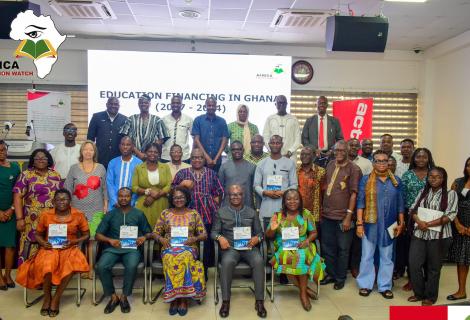ActionAid Ghana and Partners Outdoor Education Financing Tracker to address expenditure and revenue complexities in Ghana's Basic Education sector.

Globally, 44 million additional primary and secondary teachers are needed to meet Sustainable Development Goal 4, and the largest need is in Africa. The global call for improved resource allocation to education has been heightened over the last decade, with countries required to commit 4-6 percent of GDP or 15-20 percent of annual government expenditure to education. The Ghana Accountability for Learning Outcome Project, increment in Capitation Grant, increment in Ghana School Feeding Grant, absorption of BECE fee for junior high school pupils, implementation of free secondary education, free WiFi for secondary schools and other ICT interventions, review of the pre-tertiary education curriculum, and creation of new education agencies, among others, have been commendable efforts by the government to improve Ghana’s education; and as a social justice organisation, we find these efforts very important in fostering education development.
In aligning to the goal of the Continental Education Strategy for Africa (CESA) 2016-2025 which is driven by the desire to set up a “qualitative system of education and training to provide the African continent with efficient human resources, the Africa Education Watch with support from ActionAid Ghana and Oxfam Ghana has undertaken series of research, investigating the challenges confronting Ghana’s education sector. One of the strategies to frequently deliberate on financing trends and challenges of the sector is the annual education financing conference. This year’s conference sought to review the performance of the government in education in providing quality education for all.
ActionAid Ghana has made significant contributions to Ghana’s education development. Apart from the delivery of many girl-friendly model schools with ancillary facilities, promoting inclusive leadership and addressing the gender gap in decision making in many schools in AAG’s operational communities, AAG have carried out cutting edge research and surveys that have contributed to enhancing educational advancement in Ghana. In a recent development to ensure that Ghana’s education is achieving best benchmarks, we published research on Tax incentives benefits to Ghana’s education: What Tax Incentives can do for Basic Education in Ghana.
Furthermore, AAG has championed growth and leadership opportunities by ensuring inclusivity in Ghana‘s education. The research discovered that some $901m potential revenues were lost to tax incentives. The revenue could provide extra 950,527 places in schools or more schools infrastructure with the potential of 10,378 classrooms for pupils in basic schools in Ghana. It could also pay for the salary of about 10,000 newly recruited teachers for deprived communities. Additionally, the revenue could have also provided free school meals for an estimated 1 million children in basic schools. The average education expenditure in Ghana as a percentage of nominal GDP between 2017 and 2022 was 4.62 percent, and 19.31 percent as a share of government expenditure both within the international benchmarks of 4-6% and 15-20 per cent, respectively.
The government contributed the largest share of the sector's expenditure over the period, with a cumulative share of 86.7% from GoG funding which represents (74.0%), GETFund (8.7%), ABFA (3.7%), and DACF (0.2%). This was followed by internally generated funds (IGF) with 11.3% and development partner support with 2.1 percent. It was also recorded in the tracker that between 2017 and 2022, the Basic Education sub-sector received a cumulative share of 41.6 percent of the sector's budget. This was followed by secondary education (24.5%), which has 1.4 million beneficiaries, and tertiary education (23.0%), with about 711,695 beneficiaries.
However, ActionAid Ghana has discovered that, over the past seven years, the major challenges of education financing have been the thin distributions of revenues to the various sectors of education. There is also so much prioritisation of the ‘Free SHS,” while other levels receive very little attention and financing. In a bid to curtail this trend, Africa Education Watch with support from ActionAid Ghana and Oxfam, also launched the Education Financing Tracker.
The Tracker assesses education budgeting and expenditure performance from 2017 to 2024, highlights key trends, gaps, challenges, implications for achieving SDGs, and recommendations for improved resourcing of education in Ghana.
Stakeholders at the conference, spoke on the need for mechanisms and systems to be improved for better monitoring. Dr. Casley Hayford during a panel discussion reiterated that there must be systematic collaborations between Public and Private stakeholders to track sector performance report for accountability and transparency. She explained that, the report allows stakeholders and duty bearers to look at the disproportionate allocations over the years because the educational sector of Ghana is woefully under-resourced.
End.